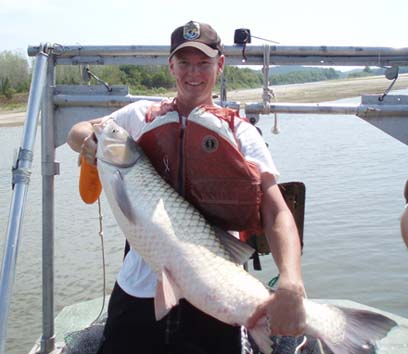Evaluation of Sampling Methods and Habitat Use of Missouri River Fishes
Investigators: 
Joshua Schloesser, M.S. student
Dr. Craig Paukert
Project Supervisor:
Dr. Craig Paukert
Funding:
US Geological Survey, SSP Program Cooperators
US Army Corps of Engineers
US Fish & Wildlife Service
Missouri Department of Conservation
Nebraska Game and Parks Commission
Location:
Missouri River, lower 1,207 km in
Missouri and Nebraska
Completion:
September 2008
Objectives:
Determine the most appropriate gears, mesh sizes, and deployment strategy to sample 25 species of Missouri River fishes with the goal of detecting trends in abundance.
Determine if Missouri River fishes associate with specific habitats and how these change along a latitudinal gradient.
Progress and Results:
Evaluating gear bias in large scale monitoring programs can help refine sampling protocols to increase the ability to detect trends in abundance. We sampled 210 river bends (each bend averages 3.5 rkm) in the lower 1,207 km of the Missouri River as part of the pallid sturgeon monitoring and assessment program using gill nets, trammel nets, otter trawls, and mini fyke nets during 2003-2006. Occupancy modeling was used to estimate detection probabilities (p) by gear type for each species' maturity class (juvenile and adult) from its presence or absence at each sampled river bend. Generally gill nets were most effective for sampling large bodied fishes and otter trawls and mini fyke nets were most effective for small-bodied fishes. Since detection probabilities generally differed among species' maturity class and gear type, it is necessary to sample with multiple gears to adequately monitor the entire fish community in the Missouri River. Final sampling recommendations for detecting trends in abundance will favor gears with the highest detection probabilities and lowest variability (e.g. coefficient of variation) in catch per unit effort.
Products:
Schloesser, J. T., C. P. Paukert, W. J. Doyle, T. D. Hill, K. D. Steffensen, and V. H. Travnichek. 2012. Fish assemblages at engineered and natural channel structures in the Lower Missouri River: implications for modified dike structures. River Research and Applications 28:1695-1707.
Schloesser, J. T., C. P. Paukert, W. J. Doyle, T. D. Hill, K. D. Steffensen, and V. H. Travnichek. 2012. Heterogeneous detection probabilities for imperiled Missouri River fishes: implications for large river monitoring programs. Endangered Species Research 16:211-224.
Schloesser, J. T., and C. P. Paukert. 2008. The use of occupancy modeling to aid the Missouri River pallid sturgeon monitoring program. Missouri River Natural Resources Conference, Nebraska City, NE.
Schloesser, J. T., C. Paukert, W. Doyle, T. Hill, G. Mestl, and V. Travnichek. 2008. Comparison of sampling gear detection probabilities and variability for Missouri River fishes. Kansas Natural Resources Conference, Wichita, KS.
Schloesser, J. T., C. Paukert, W. Doyle, T. Hill, G. Mestl, and V. Travnichek. 2007. Probability of detection and catch rate variability by gear type for Missouri River fishes. Midwest Fish and Wildlife Conference, Madison, WI.
Schloesser, J. T., J. Finley, C. P. Paukert, W. Doyle, and T. Hill. 2007. Comparison between push trawls and mini fyke nets to sample shallow water fish communities. American Fisheries Society National Meeting, San Francisco, CA.
Schloesser, J. T., J. Finley, C. P. Paukert, W. Doyle, and T. Hill. 2007. Comparison between push trawls and mini fyke nets to sample shallow water fish communities. Missouri River Natural Resources Conference & BiOp Forum, Nebraska City, NE.